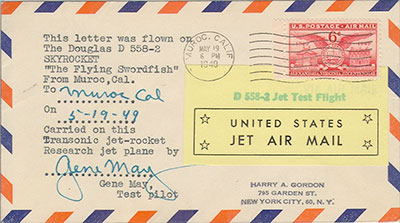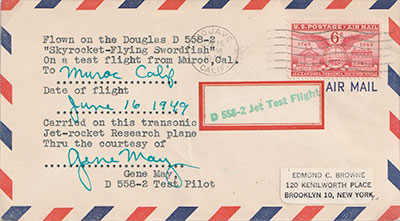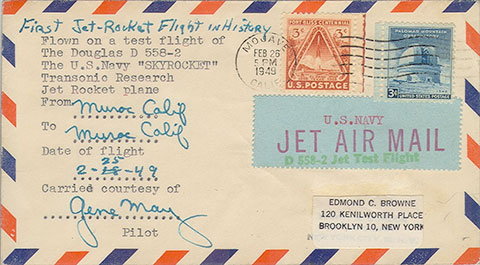Space Cover 746: Gene May and the Douglas SkyrocketWe covered the 75th anniversary of the very first flight of the Douglas D-558-II Skyrocket in Space Cover of the Week 686. That flight used only the Skyrocket's jet engine since the rocket engine was not yet available, and was flown by Douglas test pilot John Martin.
Well, a year later (a little over 75 years ago from today) John Martin had been promoted to chief test pilot at Douglas, was replaced on the Skyrocket by Douglas test pilot Gene May, and the rocket engine finally got delivered and installed. On February 25, 1949 May performed the first flight of the Skyrocket using both jet and rocket power. The cover above was carried by May on that flight and was postmarked at Mojave, CA (a lot of Muroc's mail went to Mojave for processing) the day after the flight (fairly common for Muroc/Edwards flown covers – the pilot couldn't always drop the cover into the mail on the same day of the flight). It is listed as Ellington-Zwisler (E-Z) #69, unknown quantity carried. This cover is identical to the one pictured in E-Z, so I don't know if there is more than this one in existence.
May's takeoff that day started with just the underpowered jet engine slowly accelerating the Skyrocket across the Muroc dry lakebed. With the Skyrocket heavily loaded with rocket fuel, this takeoff roll was three miles long (today's airliners takeoff in under two miles). The rocket engine wasn't fired until the Skyrocket was airborne. May and everyone else involved with the program were justifiably worried about a rocketplane full of volatile rocket and jet fuel, plodding three miles across the dry lakebed where a blown tire or some other landing gear problem could cause a really bad day.
So, on April 3 and April 27, 1949 May did takeoffs using both the Skyrocket's jet and rocket engine, lifting off the lakebed in just a half-mile! Good news! The bad news was that there wasn't much rocket fuel left for high-speed flight research at altitude. Covers are not known for these two flights.

The next solution was to attach four small strap-on rocket motors (known as JATO motors) to the Skyrocket to help it take off without using as much of the precious fuel for its main rocket engine. May made JATO flights on May 15 and 19, 1949. No covers are known for the May 15 flight, however the above was carried by him on the May 19 flight, postmarked at Muroc on the day of the flight. It is listed as E-Z #70, quantity unknown. This cover is slightly different from the one pictured in E-Z, so I know that there are at least two in existence.
On May's next flight, May 23, 1949, one of the JATO motors failed to separate after firing, causing an imbalance of both weight and drag on the Skyrocket, and fortunately May was able to immediately land. No covers known.

May performed several other flights using combinations of jet, main rocket engine, and JATO to takeoff, including the June 16, 1949 flight that was all-nominal. May carried the cover above on that flight, E-Z #71, postmarked at Mojave the day of the flight. This cover is identical to the one shown in E-Z. Another E-Z #71 sold on eBay in 2021, and it had a handwritten notation on it that said four covers were carried that day.
Not long after this, the Navy and the NACA decided that they'd had enough of the extraordinary efforts to get the Skyrocket into the air with ground takeoffs. They decided to modify the Skyrocket to be air-launched by a modified B29 bomber plane, a method that was already working quite well for the Air Force X1 rocketplane. About that time Gene May, already in his late 40's and a grandfather, decided to retire from test piloting clearing the way for another Douglas test pilot, Bill Bridgeman. We'll cover Bridgeman in a future Space Cover of the Week.














